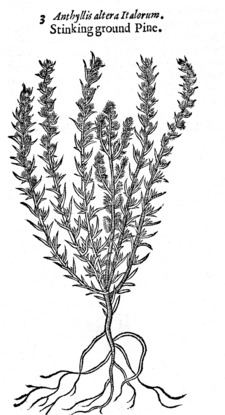
Gerard's Herbal - Part 3
|
|
|
| Fig. 929. Sea Pimpernel (1) |
Fig. 930. Many-Flowered Ground-Pine (2) |
The Kinds.
Dioscorides hath anciently mentioned two sorts of Anthyllis: one with leaves like to the Lentil, & the other like to Chamępitys. To the first, some late writers have referred divers plants, as the two first described in this Chapter; The Anthyllis leguminosa belgarum hereafter to be described; the Anthyllis valentina clusii formerly set forth Chap. 171. To the second are referred the Iva moschata monspeliaca, described in the fourth place of the 150th Chap. of this book; the Linaria adulterina described formerly chap. 165 in the 14th place, and that which is here described in the third place of this chapter, by the name of Anthyllis altera italorum.
The Description.
1. There hath been much ado among writers about the certain knowledge of the true Anthyllis of Dioscorides: I will therefore set down that plant which of all others is found most agreeable thereunto. It hath many small branches full of joints, not above an handful high, creeping sundry ways, beset with small thick leaves of a pale colour, resembling Lenticula, or rather Alsine minor, the lesser Chickweed. The flowers grow at the top of the stalk, star-fashion, of an herby colour like Box, or Sedum minus: it fostereth his small seeds in a three-cornered husk. The root is somewhat long, slender, jointed, and deeply thrust into the ground like Soldanella: all the whole plant is saltish, bitter in taste, and somewhat heating.
This description was taken out of the Adversaria, pag. 165, where it is called Anthyllis prior lentifolia peplios effigia maritima: also Clusius hath described it by the name of Alsines genus pelagicum: I have called it in my last journal by the name of Alsine cruciata marina, because the leaves which grow thick together by couples cross each other, as it happens in most plants which have square stalks with two leaves at each joint. I have Englished it Sea Pimpernel, because the leaves in shape are as like those of Pimpernel as of any other plant; and also for that our author hath called another plant by the name of Sea Chickweed. The figure of the Adversaria was not good, and Clusius hath none; which hath caused some to reckon this Anthyllis of Lobel, and Alsine of Clusius for two several plants, which indeed are not so. I have given you a figure hereof which I took from the growing plant, and which well expresseth the growing thereof.
2. There is likewise another sort of Anthyllis or Sea Ground-Pine, but in truth nothing else than a kind of Sea Chickweed, having small branches trailing upon the ground of two hands high, whereupon do grow little leaves like those of Chickweed, not unlike those of Lenticula marina, or Sea Lentils: on the top of the stalks stand many small mossy flowers of a white colour. The whole plant is of a bitter and saltish taste. This is the Marina incana anthyllis alsine folia narbonensium of Lobel: it is the Paronychia altera of Matthiolus.

Fig. 931. Stinking Ground Pine (3)
3. To this figure I will now give you a brief description. This in the branches, leaves, and whole face thereof is very like the French Herb-Ivy, or Ground-Pine, but that it is much less in all the parts thereof, but chiefly in the leaves which also are not snipped like those of the French Ground-Pine, but sharp pointed: the tops of the branches are downy or woolly, and set with little pale yellow flowers.
The Place.
These do grow in the South Isles belonging to England, especially in Portland in the gravelly and sandy fords, which lie low and against the sea; and likewise in the Isle of Sheppey near the water side. So saith our author, but I have only found the first described, and that both in Sheppey, as also in Westgate Bay by Margate in the Isle of Thanet.
The Time.
They flower and flourish in June and July.
The Names.
Their titles and descriptions sufficiently set forth their several names.
The Temperature.
These sea herbs are of a temperate faculty between hot and cold.
The Virtues.
A. Half an ounce of the dried leaves drunk, prevaileth greatly against the hot piss, the strangury, or difficulty of making water, and purgeth the reins.
B. The same taken with oxymel or honeyed water is good for the falling sickness, given first at morning, and last at night.